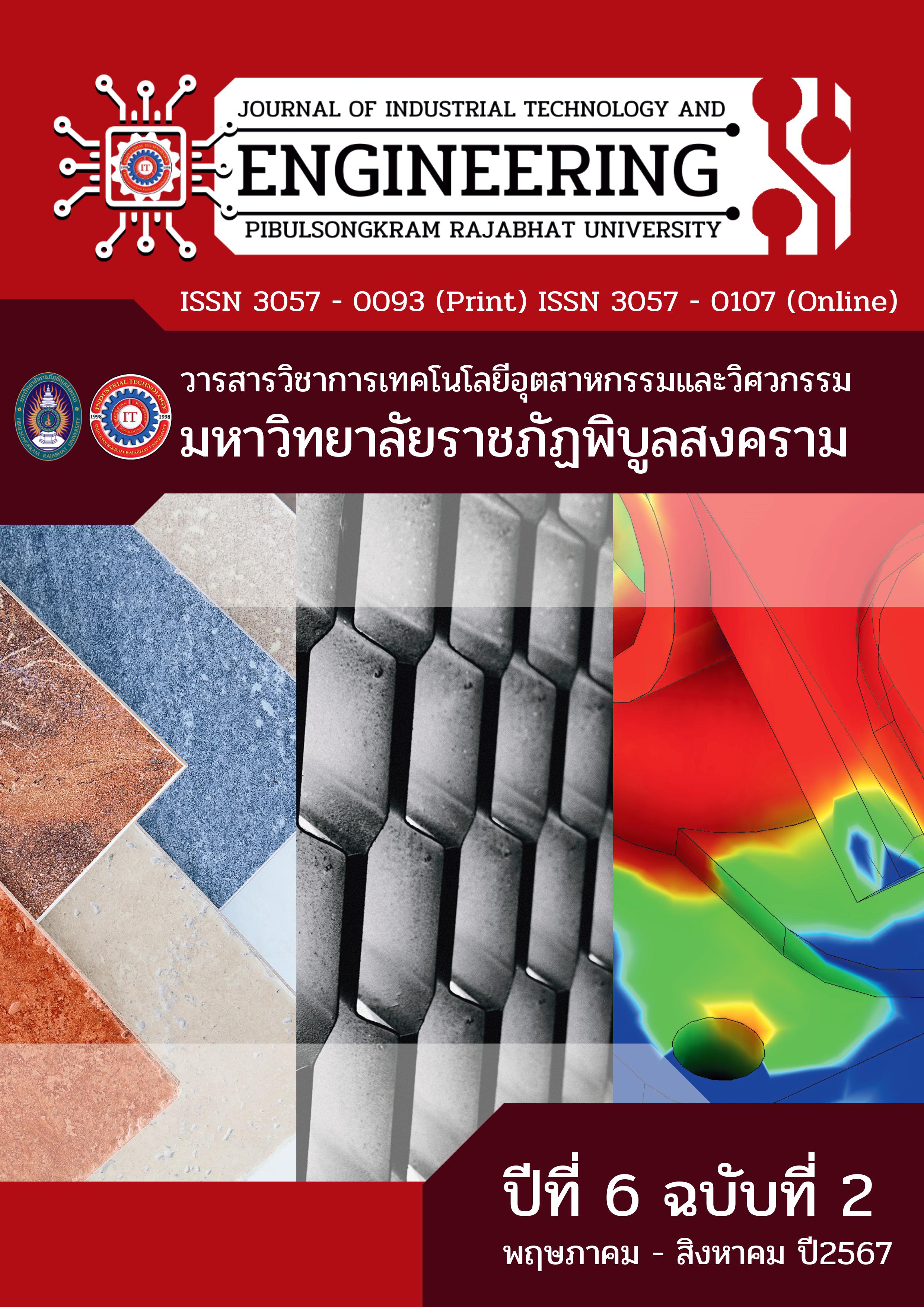การศึกษาสมบัติด้านวิศวกรรมของคอนกรีตบล็อกผสมเปลือกหอยนางรมบด
คำสำคัญ:
คอนกรีตบล็อก, เปลือกหอยนางรม, ค่ากำลังรับแรงอัดบทคัดย่อ
การศึกษาสมบัติด้านวิศวกรรมของคอนกรีตบล็อกผสมเปลือกหอยนางรมบด โดยการนำขยะเปลือกหอยนางรมบดแทนที่หินฝุ่นด้วยอัตราส่วนร้อยละ 0, 20, 40, 60, 80 และ 100 ตามลำดับ โดยน้ำหนัก ขึ้นรูปคอนกรีตบล็อก ขนาด 7 x 19 x 39 เซนติเมตร ที่อัตราส่วนผสม ปูนซีเมนต์ : หินฝุ่น เท่ากับ 1 : 6 โดยน้ำหนัก และอายุบ่มที่ 7, 14 และ 28 วัน โดยมีวัตถุประสงค์เพื่อ 1) ศึกษาสมบัติทางกายภาพและองค์ประกอบทางเคมีของเปลือกหอยนางรมบด 2) ศึกษาสมบัติทางกายภาพและสมบัติทางกลของคอนกรีตบล็อกที่ใช้เปลือกหอยนางรมบดแทนที่หินฝุ่นตาม มอก.58-2560 และ 3) ศึกษาวิเคราะห์ต้นทุนของการผลิตคอนกรีตบล็อกกลวงแบบไม่รับน้ำหนักที่ใช้เปลือกหอยนางรมบดแทนที่หินฝุ่นตาม มอก.58-2560
ผลการวิจัยพบว่า 1) เปลือกหอยนางรมบด มีองค์ประกอบหลักเป็น Calcium oxide โดยมีปริมาณเท่ากับร้อยละ 48.85 ซึ่งสูงเมื่อเปรียบเทียบกับหินฝุ่นเพียงร้อยละ 1.8 เนื่องจากเปลือกหอยนางรมบดไม่ได้ผ่านกระบวนการเผาทำให้ความชื้นและปริมาณคาร์บอนอิสระในเปลือกหอยนางรมบดยังคงมีอยู่มากส่งผลให้วัสดุมีความต้องการน้ำสูงขึ้น 2) การทดสอบหาค่าความถ่วงจำเพาะและค่าการดูดซึมน้ำของหินฝุ่นและเปลือกหอยนางรมบด มีค่าเท่ากับ 2.67 และ 2.50 และ มีค่าเท่ากับ 3.2 และ 9.3 ตามลำดับ และการทดสอบค่ากำลังรับแรงอัด พบว่าอัตราส่วนที่ร้อยละ 20 มีค่าต้านทานกำลังอัดสูงสุดมีค่าเท่ากับ 84 กิโลกรัมต่อตารางเซนติเมตร ที่อายุการบ่มสูงสุด 28 วัน 3) ต้นทุนของการผลิตคอนกรีตบล็อกกลวงแบบไม่รับน้ำหนักที่ใช้เปลือกหอยนางรมบดแทนที่หินฝุ่นที่อัตราส่วนร้อยละ 20 ของการแทนที่ตาม มอก.58-2560 สามารถลดต้นทุนราคาต่อก้อนได้ถึง 0.49 บาทต่อก้อน คิดเป็นร้อยละ 9.58 ของคอนกรีตบล็อกต่อก้อน
เอกสารอ้างอิง
ดิศสกุล อึ้งตระกูล และกิตติพงศ์ รื่นวงศ์. (2562). การพัฒนาคอนกรีตบล็อกจากใยบวบหอม. วารสารวิชาการการออกแบบสภาพแวดล้อม, 1, 92-107.
"เส้นพลาสติกรักษ์โลก" จาก "เปลือกหอยแมลงภู่" คืนชีพขยะ PLA แก้ปัญหาชุมชน ฝีมืือนาโนเทค สวทช.-จุฬาฯ. (22 พฤศจิกายน 2566). ผู้จัดการออนไลน์. ค้นจาก https://mgronline.com/greeninnovation/detail/9660000104483
Aljerf, L. (2015). Effect of thermal-cured hydraulic cement admixtures on the mechanical properties of concrete. Intercom-International Ceramic Review, 64(8), 346-356.
ASTM Standard. (2013). Standard Test Method for Density, Absorption, and Voids in Hardened Concrete. Retrieved from www.astm.org: ASTM International.
ASTM Standard. (2014). Standard Test Method for Density, Absorption, and Voids in Hardened Concrete. Retrieved from www.astm.org: ASTM International.
ASTM Standard. (2019). Standard Test Method for Sieve Analysis of Fine and Coarse Aggregates. Retrieved from www.astm.org: ASTM International.
ASTM Standard. (2019). Standard Test Method for Compressive Strength of Hydraulic Cement Mortars Using 2-in. (2020). [or 50-mm] Cube Specimens. Retrieved from www.astm.org: ASTM International.
Bahij, S., Omary, S., Feugeas, F., & Faqiri, A. (2020). Fresh and hardened properties of concrete containing different forms of plastic waste–A review. Waste Management, 113, 157-175.
Kaya, A., & KAR, F. (2016). Properties of concrete containing waste expanded polystyrene and natural resin. Construction and Building Materials, 15(105), 572-578.
Madhu, G., Bhunia, H., Bajpai, P.K., & Chaudhary, V. (2014). Mechanical and morphological properties of high-density polyethylene and polylactide blends. Journal of Polymer Engineering, 34(9), 813-821.
Paopongpaiboon, K., Boonserm, K., Chindaprasirt, P., & Horsakulthai, V. (2019). The effect of organic solvent patios on mechanical properties and thermal conductivity of walkway block from waste foam residue. The Engineering Institute of Thailand under H.M. The King’s Patronage, 30(4), 121-132.
Solomon. A., & Hemalatha, G. (2018). Experimental investigation of insulated concrete form (ICF) wall panels under quasi-static cyclic load. International Journal of Engineering and Advanced Technology (IJEAT), 8(2), 84-88.
Suwansaard, A., Kongpun, T., & Khemkhao, M. (2021). Properties of Mortar Composites from Plastic Waste. Journal of Applied Science and Engineering, 25(1), 59-70.
Suwansaard, A., Kongpun, T., & Khemkhao, M. (2022). Properties of Mortars Mixed with Polystyrene and Hemp Fiber Wastes. Applied Science and Engineering Progress, 15(1), 1-11.
Thai Industrial Standard (TIS). (2017). TIS no. 58-2560 Hollow non-loadbearing concrete masonry units. Ministry of Industry (Thailand).
Wang, R., & Meyer, C. (2012). Performance of cement mortar made with recycled high-impact polystyrene. Cement and Concrete Composites, 34(9), 975–981.



